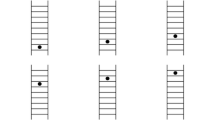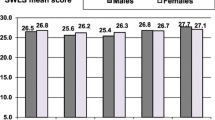Abstract
A case is made that measures used in quality of life and happiness research will be essentially unidimensional: inherently tapping minor dimensions. This is illustrated using Diener’s Satisfaction with Life Scale (SWLS). It is shown that the SWLS does not meet the standard of strict unidimensionality, but that the interpretation of the total scale score is not compromised because the additional dimensions are relatively minor. In the context of the example, a multi-step strategy is described that allows researchers to test for essential unidimensionality. Throughout the article, essential unidimensionality is contrasted with the received view of strict unidimensionality and confirmatory factor analysis methods.


Similar content being viewed by others
Notes
Note that because there is not a mathematically optimal and unique factor score estimation method, the inter-factor correlation will not equal the correlation among the two-factor scores; in our case, the interfactor correlation matrix from the Direct Oblimin rotation was .788 whereas the factor scores are correlated .701 for those same two factors.
References
Browne, M. W., & Cudeck, R. (1993). Alternative ways of assessing model fit. In K. A. Bollen & J. S. Long (Eds.), Testing structural equation models (pp. 136–162). Newbury Park, CA: Sage.
Byrne, B. M. (1998). Structural equation modeling with LISREL, PRELIS, and SIMPLIS: Basic concepts, applications, and programming. Mahwah, NJ: Lawrence Erlbaum Associates.
Church, A. T., & Burke, P. J. (1994). Exploratory and confirmatory tests of the Big Five and Tellegen’s three- and four-dimensional models. Journal of Personality and Social Psychology, 66, 93–114. doi:10.1037/0022-3514.66.1.93.
Diener, E., Emmons, R. A., Larsen, R. J., & Griffin, S. (1985). The satisfaction with life scale. Journal of Personality Assessment, 49, 71–75. doi:10.1207/s15327752jpa4901_13.
Hubley, A. M., & Zumbo, B. D. (1996). A dialectic on validity: Where we have been and where we are going. The Journal of General Psychology, 123, 207–215.
Humphreys, L. G. (1952). Individual differences. In C. P. Stone & D. Taylor (Eds.), Annual review of psychology (Vol. 3, pp. 133–147). Palo Alto, CA: Annual Reviews, Inc.
Humphreys, L. G. (1962). Organization of human abilities. The American Psychologist, 17, 475–483. doi:10.1037/h0041550.
Humphreys, L. G. (1970). A skeptical look at the pure-factor test. In C. E. Lunneborg (Ed.), Current problems and techniques in multivariate psychology: Proceedings of a conference honoring Professor Paul Horst. Seattle: The University of Washington.
Humphreys, L. G. (1982). Systematic heterogeneity of items in tests of meaningful psychological attributes: A rejection of unidimensionality. University of Illinois (Unpublished).
Humphreys, L. G. (1985). General intelligence: An integration of factor, test, and simplex theory. In B. B. Wolman (Ed.), Handbook of intelligence: Theories, measurement, and applications. New York: Wiley.
Judge, T. (1990). Job satisfaction as a reflection of disposition: Investigating the relationship and its effects on employee adaptive behaviors. Doctoral Dissertation, University of Illinois.
Kane, M. (2006). Validation. In R. Brennan (Ed.), Educational measurement (4th ed., pp. 17–64). Westport, CT: American Council on Education and Praeger.
McDonald, R. P. (1999). Test theory: A unified treatment. Mahwah, NJ: Lawrence Erlbaum Associates Press.
Muthén, B., & Kaplan, D. (1985). A comparison of some methodologies for the factor analysis of nonnormal Likert variables. The British Journal of Mathematical and Statistical Psychology, 38, 171–189.
Muthén, B., & Kaplan, D. (1992). A comparison of some methodologies for the factor analysis for non-normal Likert variables: A note on the size of the model. The British Journal of Mathematical and Statistical Psychology, 45, 19–30.
Pavot, W., & Diener, E. (1993a). The affective and cognitive context of self-reported measures of subjective well being. Social Indicators Research, 28, 1–20. doi:10.1007/BF01086714.
Pavot, W., & Diener, E. (1993b). Review of the satisfaction with life scale. Psychological Assessment, 5, 164–172. doi:10.1037/1040-3590.5.2.164.
Vautier, S., Mullet, E., & Jmel, S. (2004). Assessing the structural robustness of self-rated satisfaction with life: A SEM analysis. Social Indicators Research: An International and Interdisciplinary Journal for Quality-of-Life Measurement, 68, 235–249.
Vittersø, J., Røysamb, E., & Diener, E. (2002). The concept of life satisfaction across cultures: Exploring its diverse meaning and relation to economic wealth. In E. Gullone & R. A. Cummins (Eds.), The universality of subjective wellbeing indicators (pp. 81–103). The Netherlands: Kluwer Academic Publishers.
Zumbo, B. D. (Ed.). (1998). Validity theory and the methods used in validation: Perspectives from the social and behavioral sciences. Social Indicators Research: An International and Interdisciplinary Journal for Quality-of-Life Measurement, 45(1–3), 1–509.
Zumbo, B. D. (2007). Validity: Foundational issues and statistical methodology. In C. R. Rao & S. Sinharay (Eds.), Handbook of statistics: Psychometrics (Vol. 26, pp. 45–79). The Netherlands: Elsevier Science B.V.
Zumbo, B. D., Sireci, S. G., & Hambleton, R. K. (2003). Re-visiting exploratory methods for construct comparability and measurement invariance: Is there something to be gained from the ways of old? In Annual Meeting of the National Council for Measurement in Education (NCME), Chicago, Illinois.
Author information
Authors and Affiliations
Corresponding author
Rights and permissions
About this article
Cite this article
Slocum-Gori, S.L., Zumbo, B.D., Michalos, A.C. et al. A Note on the Dimensionality of Quality of Life Scales: An Illustration with the Satisfaction with Life Scale (SWLS). Soc Indic Res 92, 489–496 (2009). https://doi.org/10.1007/s11205-008-9303-y
Received:
Accepted:
Published:
Issue Date:
DOI: https://doi.org/10.1007/s11205-008-9303-y




